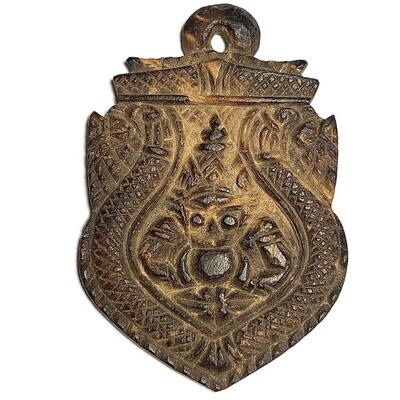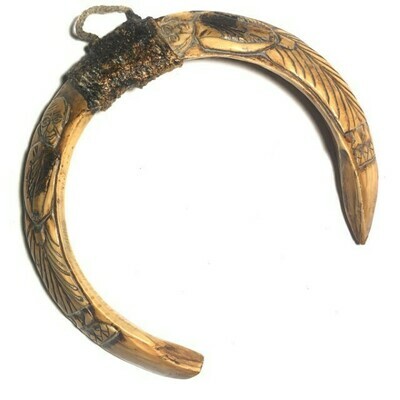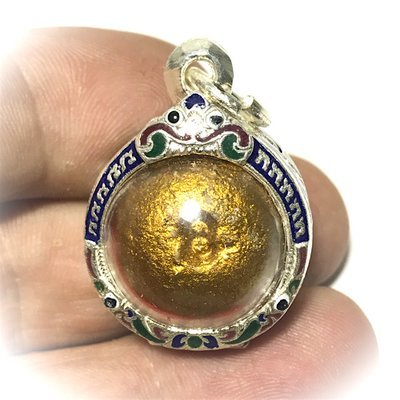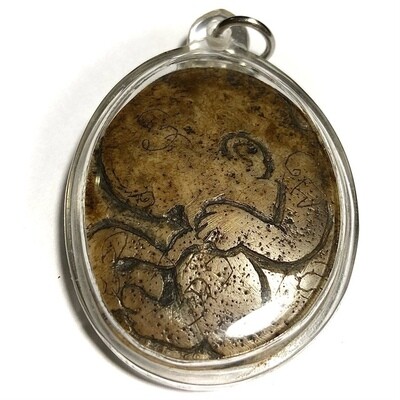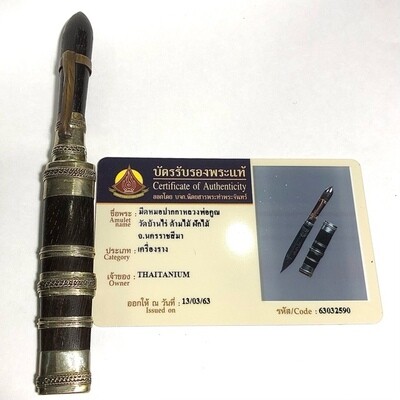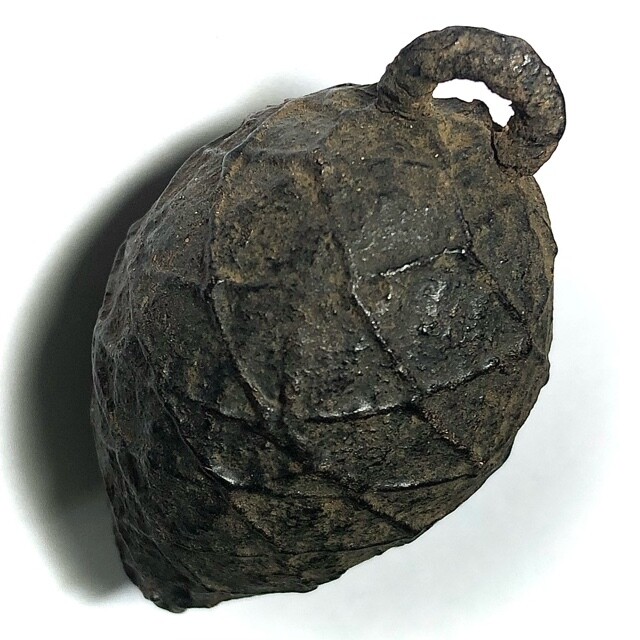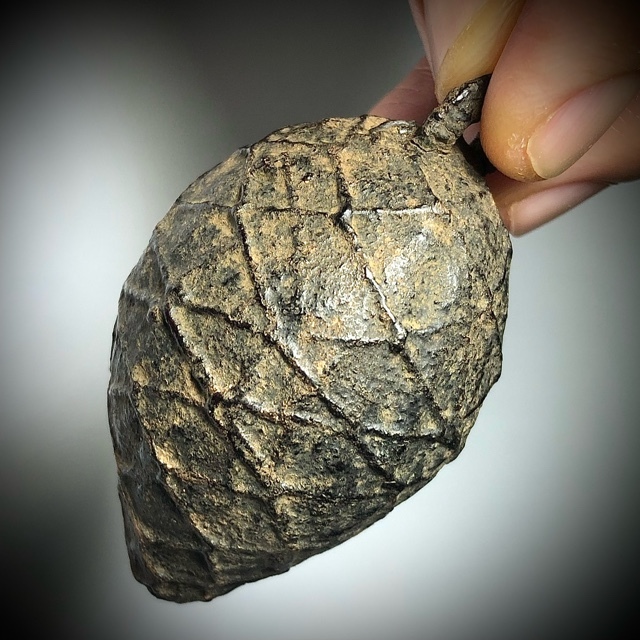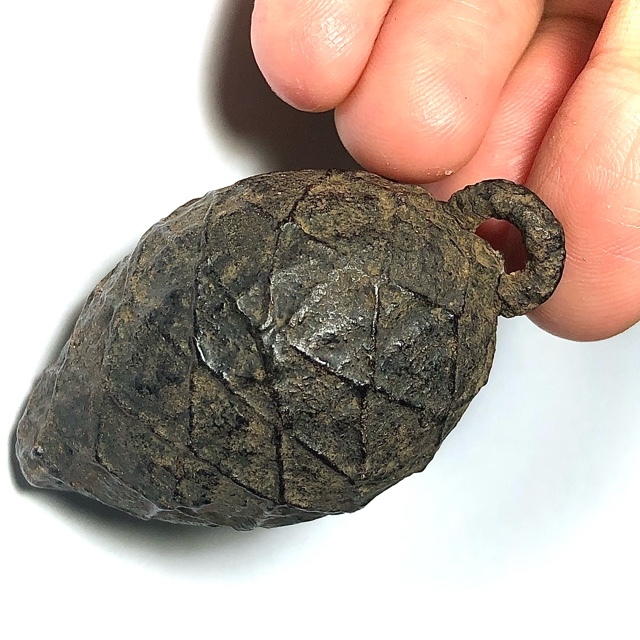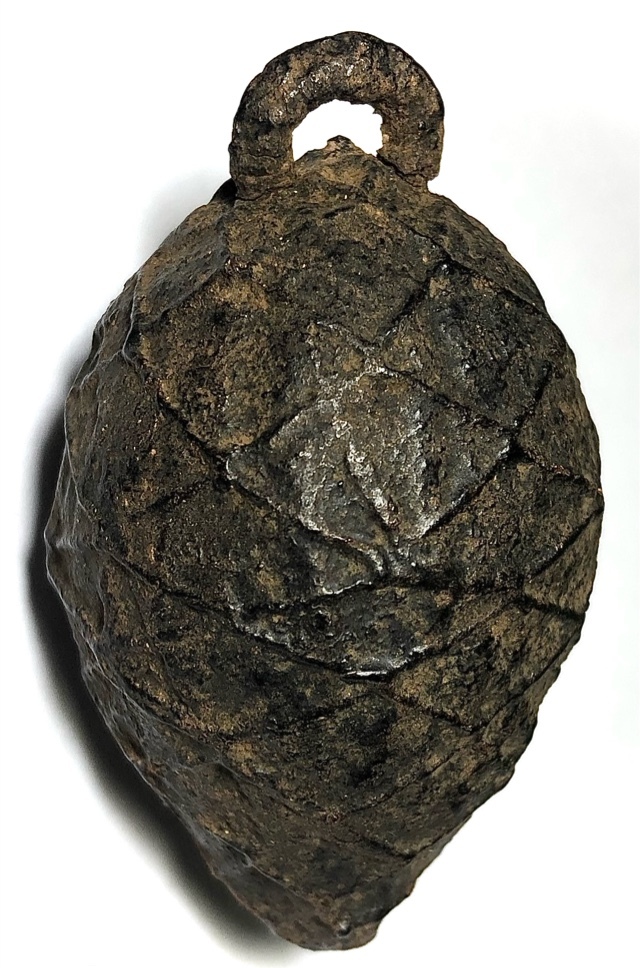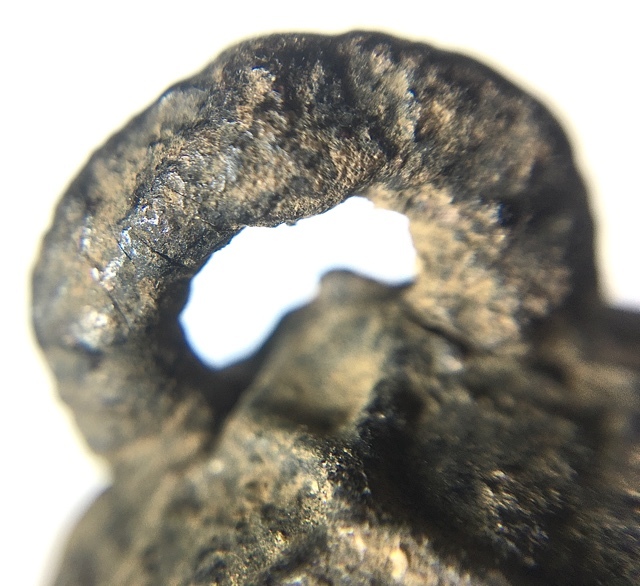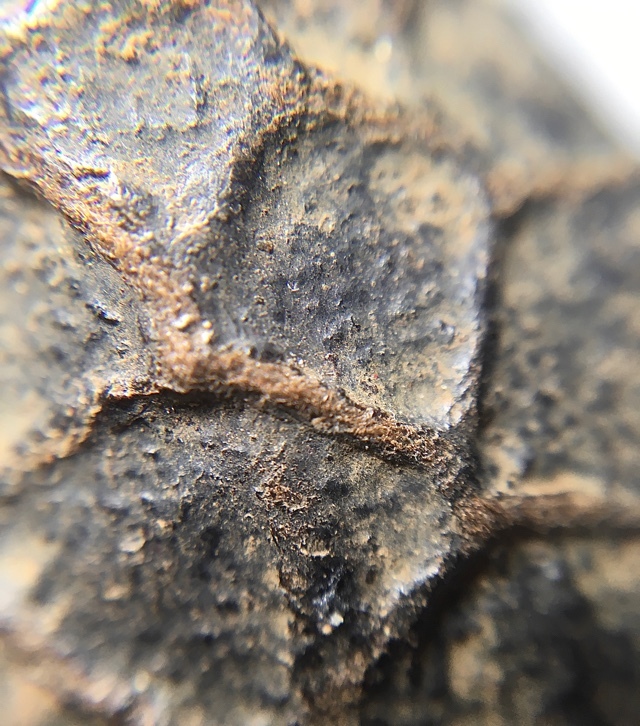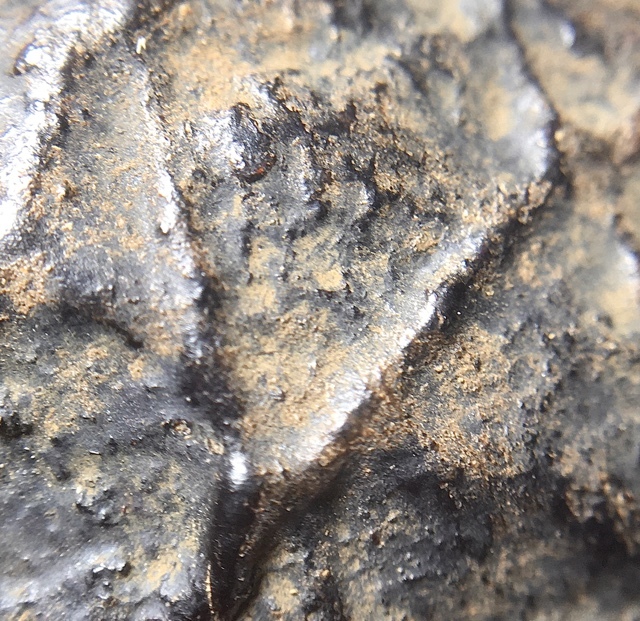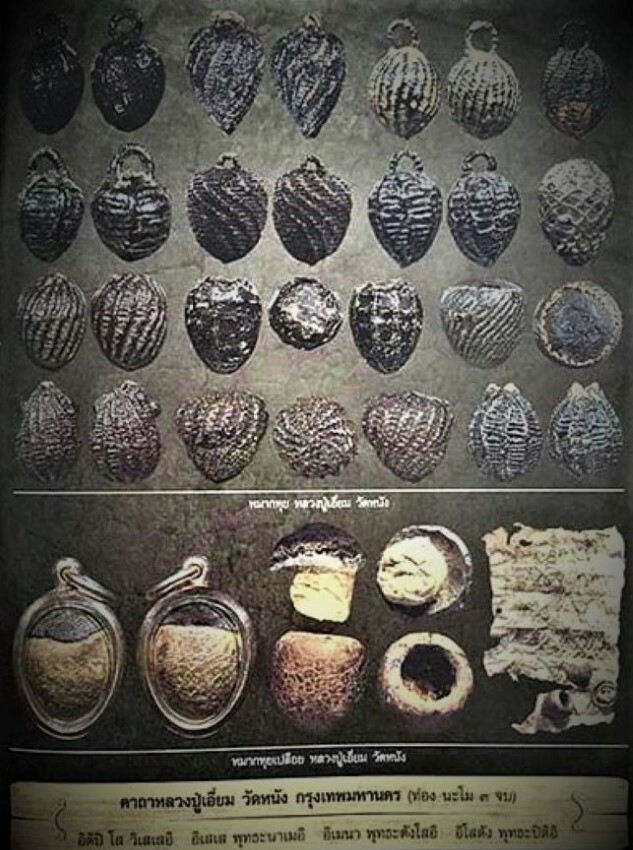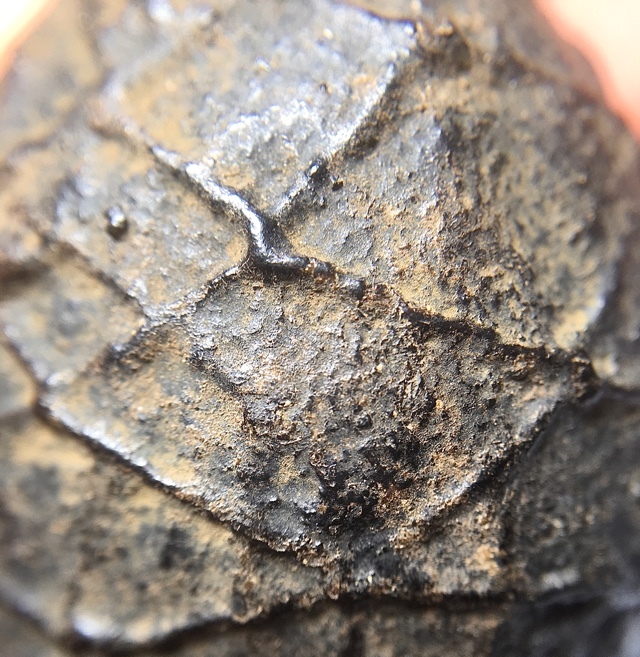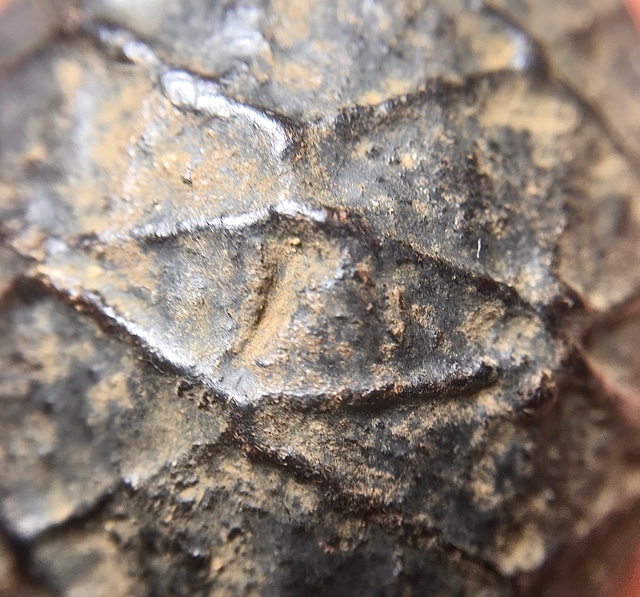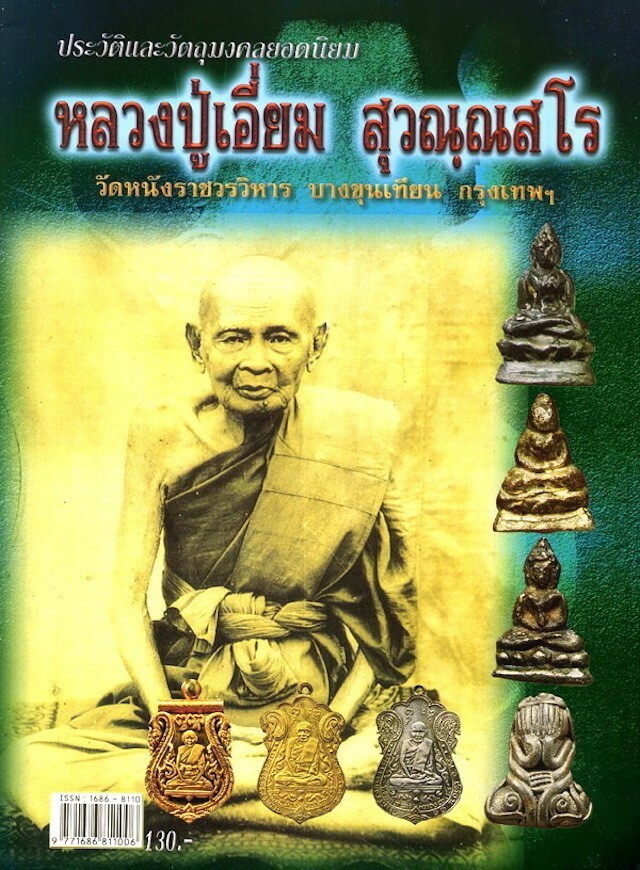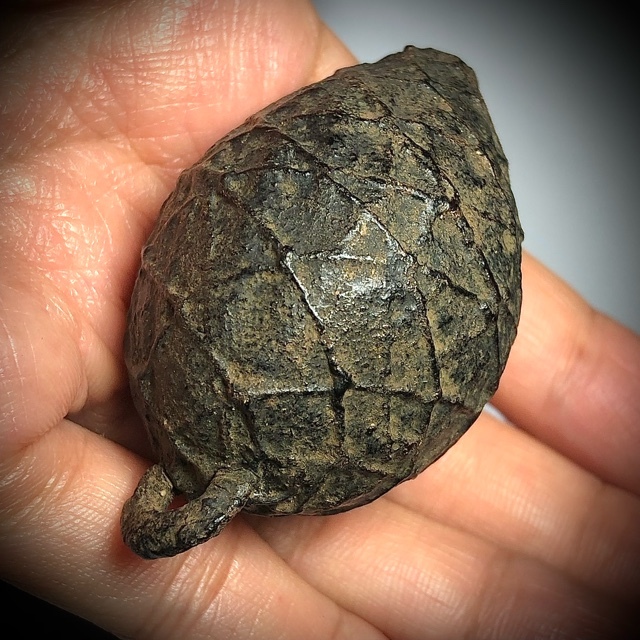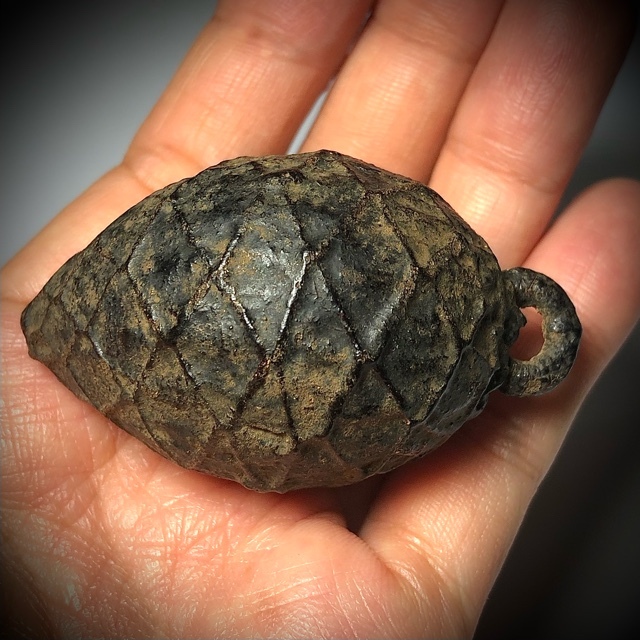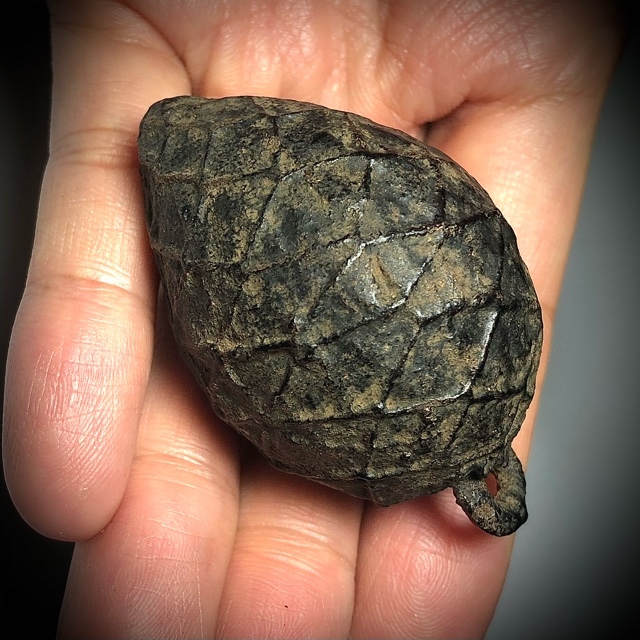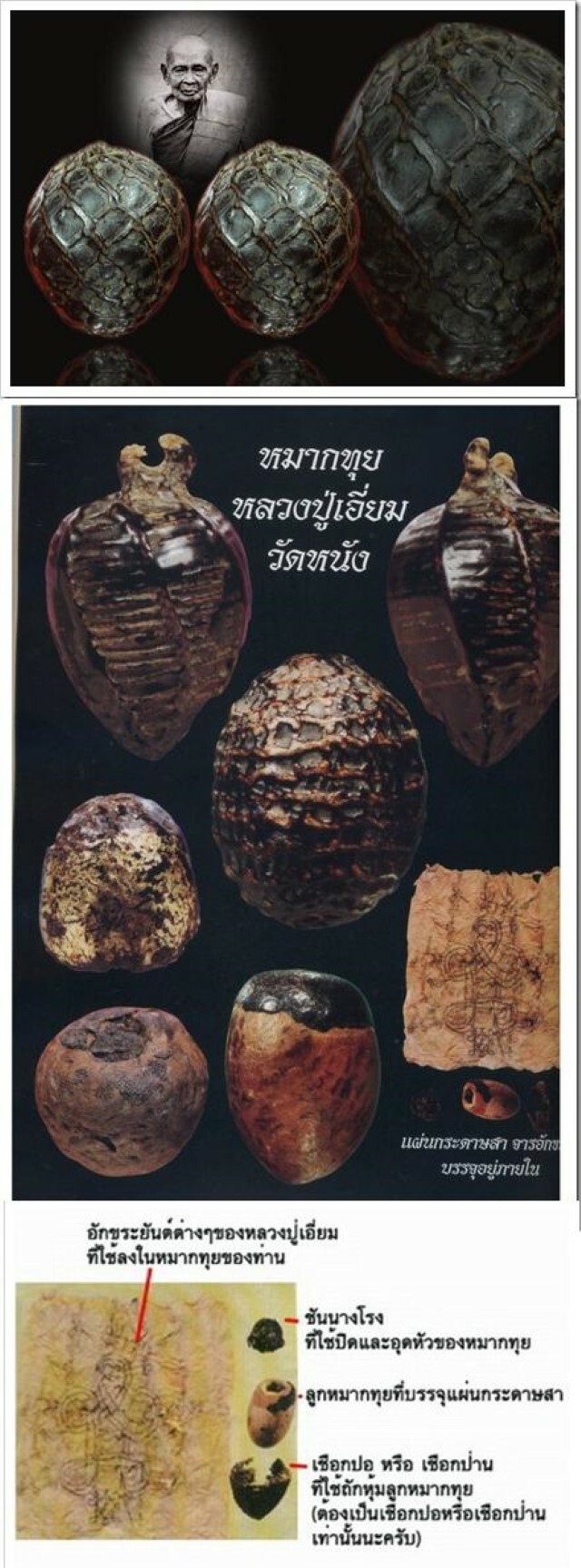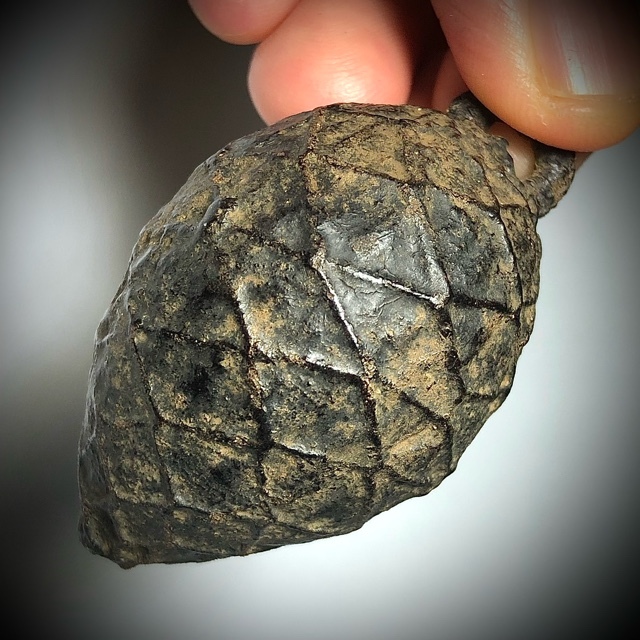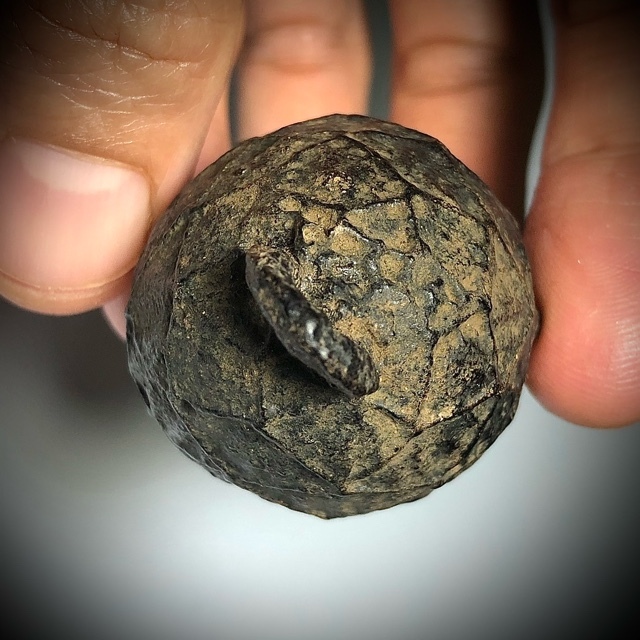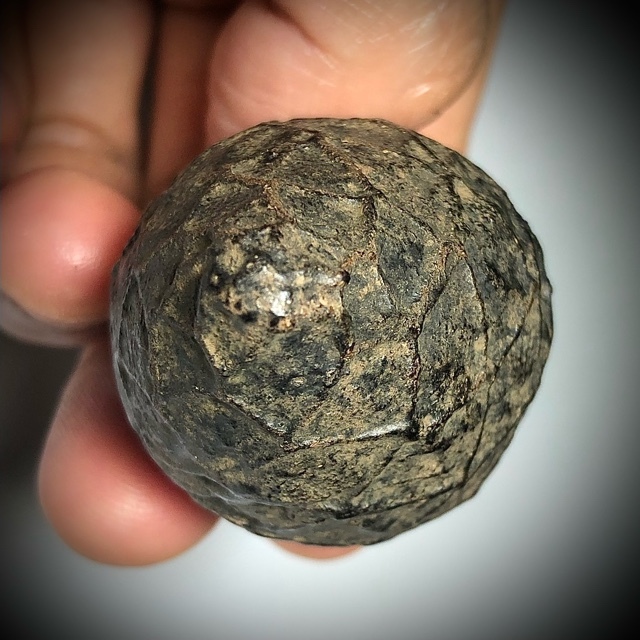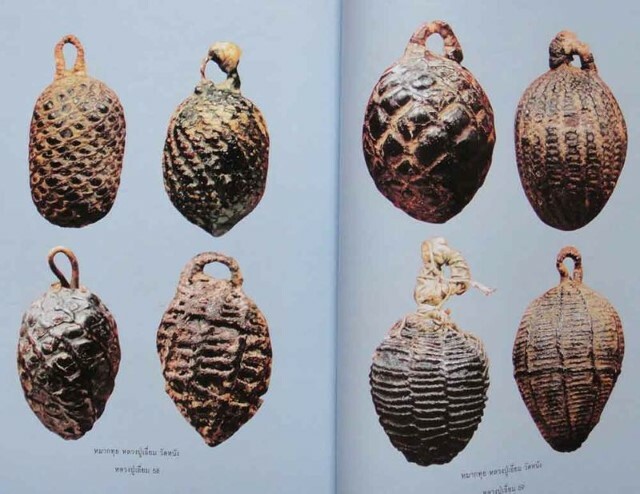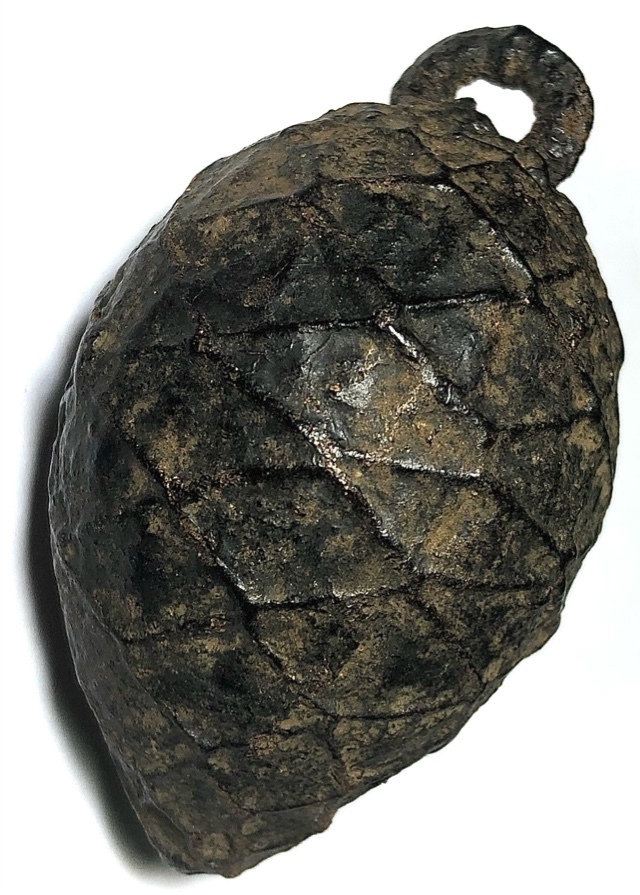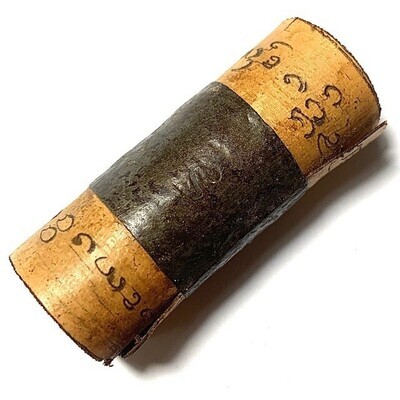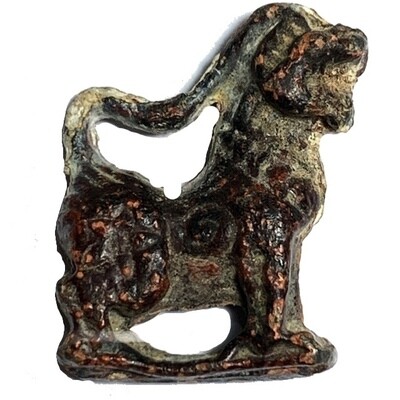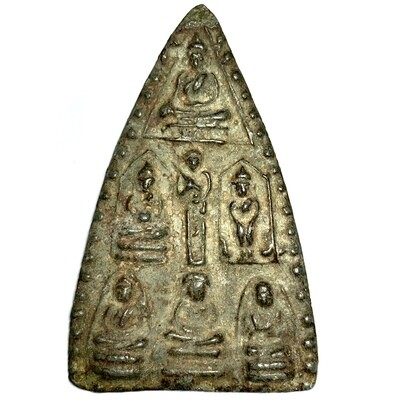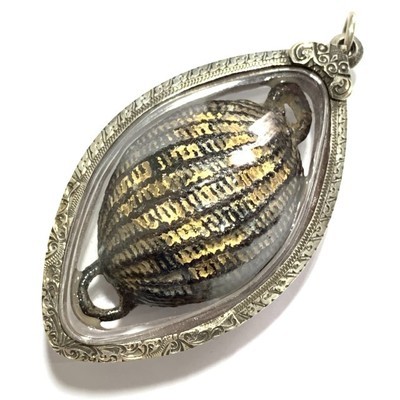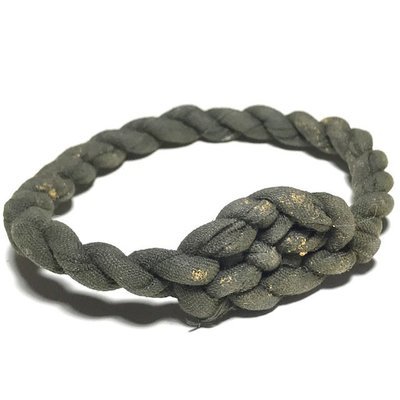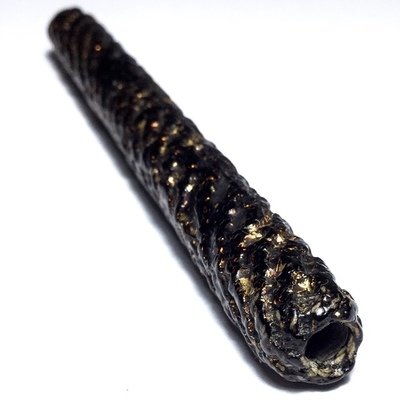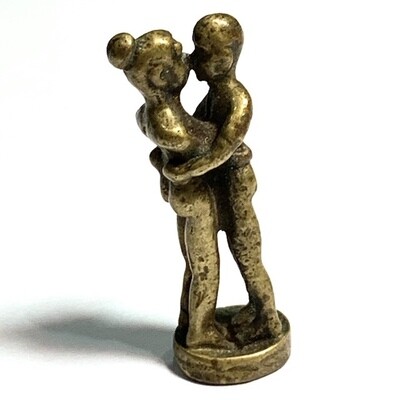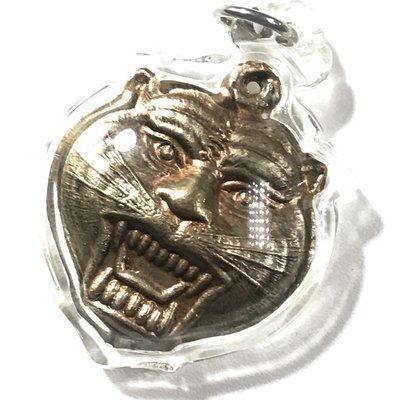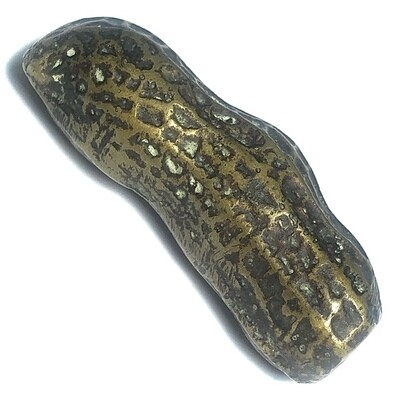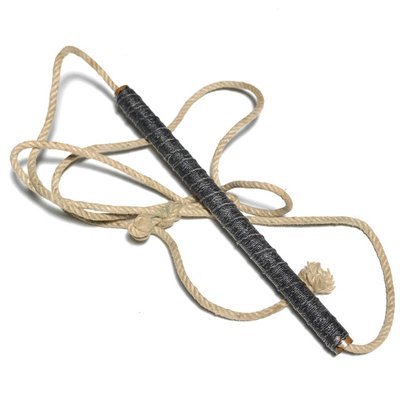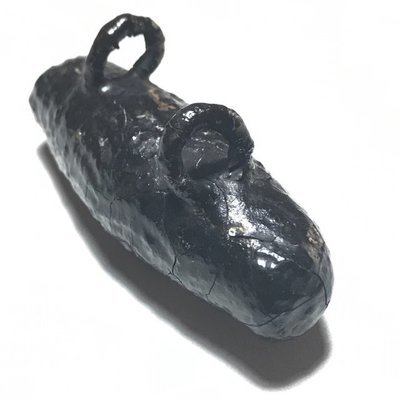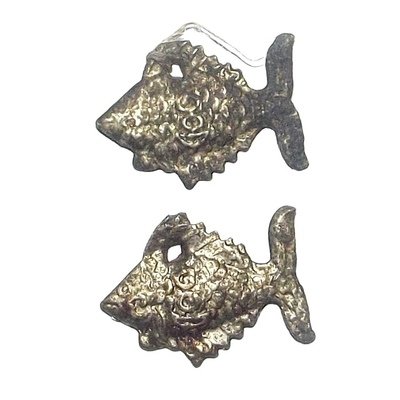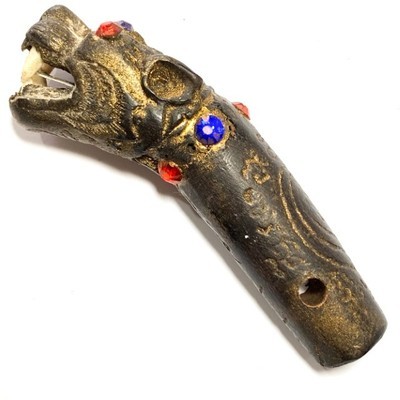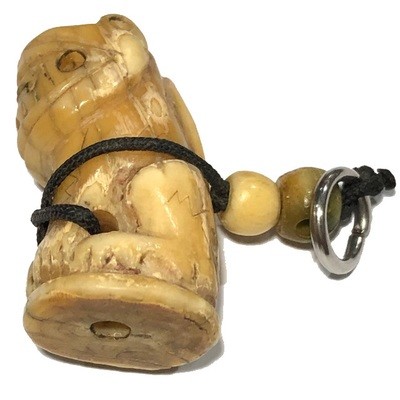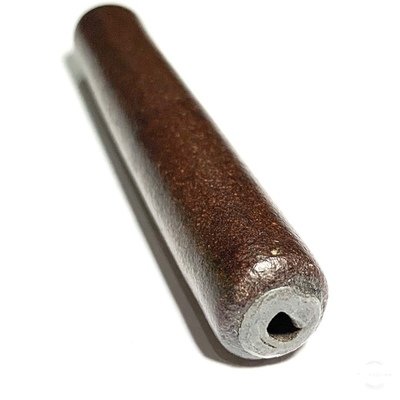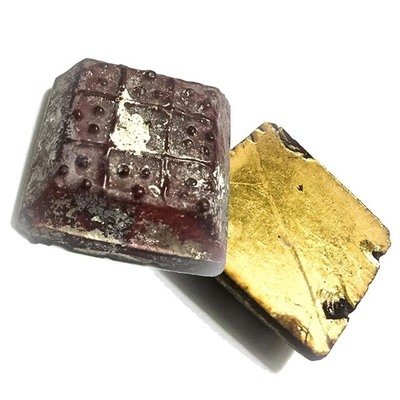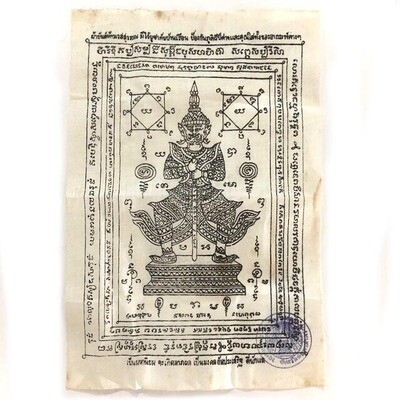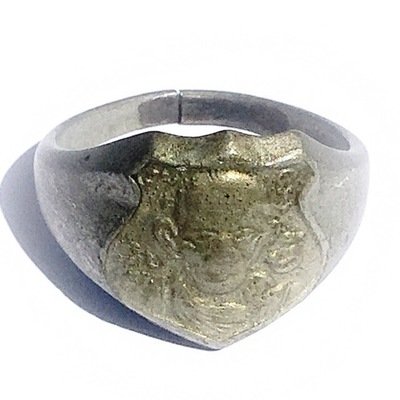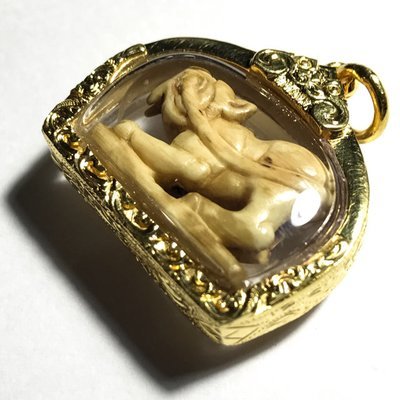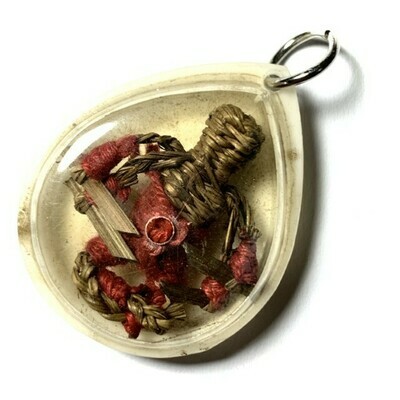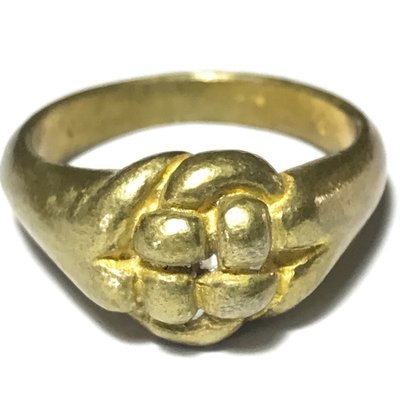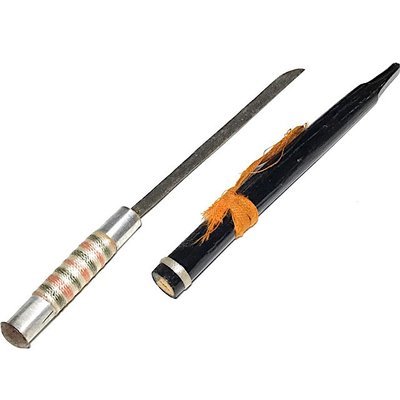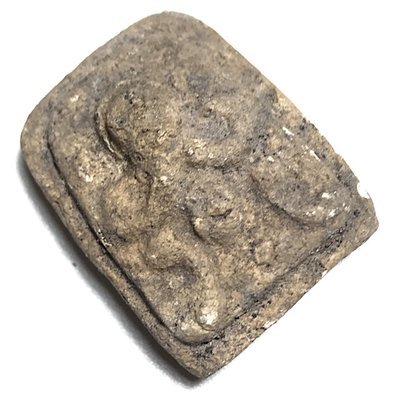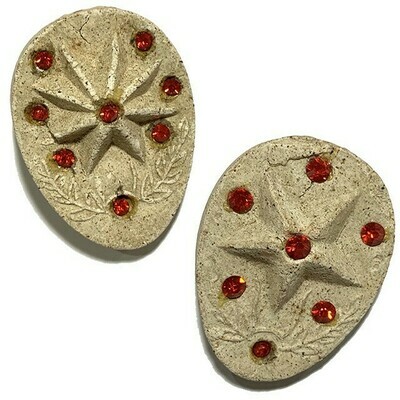A pristinely kept and extremely rare Rian Mangorn Koo Nuea Nava Loha Pim Pised Dtok Sorng Code Ma Wat Pha Nong Lom Run Sao Ha Maha Sethee 5th Lunar Saturday Blessing Ceremony Edition Guru Monk Coin, released in 2543 BE, to raise funds for the Kuti Songk Monks Huts and improve the facilities at the temple of Wat Pha Nong Lom.
This model of Rian Mangorn Koo twin dragons Monk Coin is a very rare Pim Pised (Niyom preferred) and differs from the majority of Rian Mangorn Koo Wat Pha Nong Lom Edition coins in Nava Loha, because of the double code MA stamp. Most coins of the Nava Loha series made for Wat Pha Nong Lom have only a single code Ma Stamp (on the Sangkati chest sash of the robe of Luang Phu), and only the Pim Pised special models received double code stamps. Only very few (unknown number) were distributed with double code stamp, making this not only a sacred, powerful master class amulet, but also a rare collectors piece.
The Rian Mangorn Koo of Luang Phu Hmun is, as are all of his amulets, known for the power of Jaroen Lap Wealth Increasement, and Lucky Fortunes, as well as for their Miraculous Protective Powers. Those born in the year of the dragon love to Bucha this amulet especially, for the obvious reason of the double dragon guardians.
For those with lower budgets, who seek power above collectability and rarity, we recommend to seek the Rian Mangorn Nuea Tong Daeng or Nava Loha single Code Ma, of the same edition, which carries a lower price than this special Nava Loha Pim Pised Gammagarn double code collectors edition model.
Hmak Tui Mad Chueak Takhai Paetch Long Rak Dtua Jumbo Sacred Areca Nut 2450 BE Luang Phu Iam Wat Hnang
A Jumbo sized and extremely rare version of the famously powerful, and immensely rare Sacred Hmak Tui Mad Chueak Takhai Paetch, cord bound lacquered Blessed Areca Nut, in its preferred (Niyom) version, from the Great Luang Phu Iam, of Wat Hnang. The Hmak Tui Sacred Areca Nut amulet is one of the top World Famous Classic Pra Niyom Master Class Ancient Amulets from the Great Luang Phu Iam Suwannasarō (2375 - 2469 BE), of Wat Hnang (and Wat Ko Non). Estimated Early to Mid Era Circa 2440 - 2450 BE.
Free Registered Express Shipping Worldwide is Included with this Amulet. The Hmak Tui is 'Mad Chueak Lai Takhai Paetch Long Rak' (Indra's Diamond Net pattern cord wrap, with herbal laquer coating). This Hmak Tui is a very rare, but well documented model, which stands out for its 'Ta Khai Paetch' classic and easy to recognise criss-cross cord wrap ('Diamond Net of Indra').
This exhibit is special in the fact that it is an extremely rare Jumbo sized exhibit, measuring 5.5 x 3.5 Cm Large!
Released in the Era that Luang Phu Iam was already abbot of Wat Hnang, in the decade between 2445 and 2450 BE. The amulet has been coated in Rak Chart Jeen Red Chinese Herbal lacquer, which was a common practice in Olden days, to preserve amulets and give them a long life. The Rak Chart Jeen Boran ancient lacquer has blackened over the years, showing the natural aging characteristics, as is expected in that of an authentic Pra Niyom Class Ancient Amulet.
The Hmak Tui is estimated to have been made around 2440 - 2450 BE. Luang Phu Iam made amulets from an early stage, ever since the times he was still following his Mentor Luang Phu Rod, at Wat Ko Non. He began to make amulets long before his famous first edition Pra Pid Ta Yant Yung and Pra Pid Ta Pid Tawarn, which were released at Wat Hnang around 2440 - 2443 BE.
His famous and incredibly expensive Pra Pid Ta Yant Yung/Pid Tawarn were made from metallic alchemical metals, after Luang Phu Iam had moved there as abbot, and were made one by one, in the same method as Pra Pid Ta Wat Tong of Luang Por Tap (No.1 Pra Pid Ta Amulet of all Time).
Luang Phu Iam was a World Famous Master Monk of the previous Century, and maker of the Number 2 Amulet of the Top 5 'Benjapakee' of Pra Pid Ta of all Thai Buddhist History, the Pra Pid Ta. His most famed of all were the Pra Pid Ta Yant Yung and Pra Pid Tawarn amulet.
Luang Phu Iam also made a large variety of other amulets, such as his famous hand carved Pra Pid Ta, many of them being originals from different artisans who hand carved them from various sacred woods, ivory, and other materials.
Luang Phu Iam is the No.2 Master of all History, renowned for Pra Pid Ta Amulets, and his Rare and Powerful First Edition 2467 BE Monk Coin, which fetches extremely high prices in auctions (Circa 100 Thousand Dollars).
Pra Pāwanā Gosol Thēra (Luang Phu Iam Suwannasārõ)
Luang Phu Iam was a born on Friday the 7th October 2375 BE. Luang Phu Iam was born a Citizen of Bang Khun Tian, whose household lived on the banks of the Klong Bang Hwa Canal, behind the temple of Wat Hnang. Luang Phu Iam was born during the reign of His Majesty Prabat Somdej Pra Nang Glao Jao Yuu Hua King Rama 3.
Luang Phu Iam was given the birthname of ‘Iam’ and his surname was ‘Tong U’. The devotees of Wat Hnang temple did not call him Luang Phu Iam, rather, preferred to call him ‘Luang Por Phu Tao’. People in General, and the collectors of the amulet appreciation societies like to refer to Luang Phu Iam as ‘Luang Por Wat Hnang’. His father and mother’s names were Mr. Tong, and Mrs. U, with the surname ‘Tong U’.
Luang Phu Iam’s family were market gardners, and were relatively prosperous. At the age of 9 years old, Luang Phu Iam was taken to the temple of Wat Hnang, to learn to read and write, and practice Khom Agkhara, under the tutelage of his first mentor, Luang Phu Rod, then Vice Abbot of Wat Hnang.
In the year 2387 BE, Luang Phu Rod then began to teach him Wicha Akom Buddha Magic and also to teach him in the Pali Sanskrit scripts, and the Khom Agkhara used for Magical Inscriptions. At the age of 11, in the year 2386 BE, Luang Phu Iam also went to study Pali Sanskrit with Pra Maha Yim at Wat Bovornives Voraviharn.
After he finished his studies with Pra Maha Yim, Luang Phu Rod then went to practice under the tutelage of Pra Pidok Gosol (Luang Por Chim), at Wat Liab. Thereafter, he returned to Wat Hnang, and ordained as a Samanera Novice Monk, and studied the Dhamma in his original place of learning at Wat Hnang. Luang Phu spent many years focused on study and practice, for about one decade, until the year 2394 BE.
Luang Phu was now coming of age where he should ordain from Samanera to become full status of an adult Bhikkhu, and had to go to the Royal Sanam Luang to take his Pali Sanskrit exams, which were at that time, done orally, answering in front of the teacher without any written questions to answer. Luang Phu did not pass the test. Because of failing his Pali exam, Luang Phu decided to disrobe and go to help his parents and relatives at home.
But Luang Phu only managed to remain a layman for three years, and his true calling became evident, and Luang Phu returned in the year 2397 BE to Re-Ordain as a Bhikkhu in the Buddha Sasanā at Wat Jom Tong, at the age of 22 years old.
Luang Por Gerd was his Upachaya Ordaining Officer, and gave Luang Phu Iam the Ordained Name of ‘Suwannasaro’. His Pra Gammawājājārn was Pra Tamma Chedi (Luang Por Jeen), with Pra Pawanā Gosol Thēra (Luang Phu Rod) as his Prompting Officer.
Once he had Re-Ordained again, Luang Phu Tao (Luang Phu Iam) went to stay at Wat Nang Nong, which was across the other side of the path to Wat Nang Nong. Here he continued his written studies of the Dhamma and Sorcery Grimoires, and Mastery of various Wicha, in the Samnak of Luang Por Jeen, with supplementary tuition from Pra Sangworn Wimol (Luang Por Hmen).
This time Luang Phu Iam went to finish his exams once more at Sanam Luang, and passed with flying colours. The ordained professor of Pali who was examining him, then said he had given very good translations, and invited Luang Phu Iam to come and practice at the same Samnak.
Luang Phu Iam however, refused, and continued with his usual trajectory. He then focused deeper on his practice of Vipassana Mindfulness Practice, and Puttakom (Buddha Magic) with Luang Phu Rod (who was now abbot of Wat Nang Nong).
Some time after the passing of his Mentor Luang Phu Rod, in the year 2441 BE, Luang Phu Iam was called upon by his Majesty King Prabat Somdej Pra Julajom Glao Jao Yu Hua (Rama 5), to become the abbot of Wat Hnang, and perform the duty of its maintenance and further development.
Luang Phu Iam proved to be a Great Abbot, and diligently restored and developed the temple and its facilities. Luang Phu Iam was a highly favoured Monk of His Majesty King Rama 5, and was more often than not always requested to attend the most important Blessing Ceremonies, and Buddhist Rituals of the Royal Palace. His name 'Pra Pawana Gosol' was bestowed upon him by his Majesty the King, at the time he was given the charge of Wat Hnang temple.
Luang Phu Iam then spent 27 Years working selflessly for the temple and devotees of Wat Hnang, for another 27 years, until his passing on the 26th April 2469 BE, at the age of 94.
LP Iam's Pra Pid Ta Yant Yung metallic amulet, is equally highly regarded as top five, and revered for its Klaew Klaad Kong Grapan Chadtri Maha Ud power, and seen as the equal to the famous Pra Pid Ta Rae Bang Phai, and the Pra Pid Ta Wat Tong, and the Pra Pid Ta Pim Tapap of Wat Sapan Sung.
It can be seen from historical documentation, that Luang Phu Iam followed the footsteps of of Luang Phu Rod, in the same way that Somdej Pra Puttajarn (Dto) Prohmrangsri of Wat Rakang Kositaram had followed in the footsteps of his Mentor Pra Sangkarach (Sukh Gai Thuean). Luang Phu Iam hense masters the various Wicha with his diligence and unquestioning service to Luang Phu Rod as his Mentor.
This comparison is also extendible to the amulets of both Masters, just as Somdej Pra Puttajarn (Dto) Prohmrangsri learned the Wicha Pra Somdej from Somdej Pra Sangkarach Sukh (maker of the Pra Somdej Arahang Benjapakee Amulet), so, in turn, did Luang Phu Iam make powerful Pra Pid Ta and Pra Pid Tawarn amulets, in the same Dtamra (formula) of his Mentor Luang Phu Rod.
The third Comparison between the two Monks, reveals that both Somdej Pra Puttajarn (Dto) Prohmrangsri and Luang Phu Iam managed to attain the same fame and reverence as their Mentors, and their amulets became equally reputed for their magical power.
Luang Phu Iam created the same style of imagery as Luang Phu Rod for both kinds of Pid Ta amulets, his Bia Gae, Look Om, and Hmak Tui, and his Wicha is so equal in power to that of Luang Phu Rod, that one will often seen devotees collecting the amulets of both masters with equal fervency. It is not uncommon to see a high-end collector wearing a Luang Phu Iam amulet alongside one from Luang Phu Rod on the same necklace.
